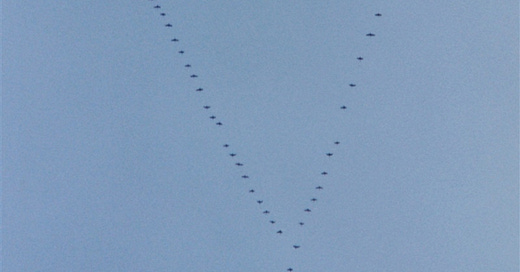The other morning I stepped out the side door to take Frances to school and heard a chorus of trumpets. It was jazzy, weird, playing to a time signature I couldn’t fathom. I scanned the alley for clues: whose patio door was thrown open at 7:30 in the morning, announcing to the neighborhood their jazz ensemble? Which of my artsy neighbors had I failed to meet? Then they flew by. Two flocks of geese, both in V-formation, honked, cracked, hooted, scronked, ploofed, croaked, crooned, warbled, chirruped, trilled. I was dumbfounded. I genuinely thought I was hearing Ornette Coleman’s “Eventually” or the opening to Anthony Braxton’s “6-77AR-36K.”
I said, “Whoa!” and stopped dead.
Frances looked at me. “What?”
“The geese,” I said. “Like trumpets, like jazz. Listen.”
We looked up and listened, watched until they flew from view.
“Amazing,” I said.
“Oh yeah,” she said.
+++
In Rick Rubin’s The Creative Act: A Way of Being, he says, “Our point of reference for beauty is nature.” He goes on to explain how the Great Pyramid and other landmarks and artistic masterpieces “rely on the same geometry found in nature.” David Foster Wallace once said, in an interview with Michael Silverblatt on Bookworm, that he structured Infinite Jest with fractals in mind. I once heard a talk by Pam Houston, who said her widely anthologized story, “How to Talk to a Hunter,” was a corkscrew. She didn’t understand why, but it just was. The novelist Sheila Heti takes an organic approach: “What else can an author do but try to create, with the book they are writing, a shape that is satisfying in the cavern of their own mind; something that seems to them to have a certain movement and harmony, and the most pleasing dimensions.”
+++
For spring break this year we went to Palm Springs, and, though it’s neither small nor free of noise, it is quiet. The city imposes a strict ordinance of no outdoor amplified music, so our pool days were spent in relative quiet. We laughed, talked, played silly games, breaked for lunch and ping-pong, and lazed in the hammock, but the in-betweens were free of clutter. When we got back to the Cities, I was more aware of noise than ever. It seemed someone had cranked the volume. Maybe I’m just getting older and am becoming more sensitive to the din of garbage trucks and construction, but I have been trying to take it—the noticing—less as an acceptance of desensitization and more as a signal to stay open to states of micro relaxation, however small and fleeting they may seem. Maybe it’s the accumulation that weighs us down. Last week I deleted the Instagram app from my phone. (We’ll see how long it lasts.) I’m putting books down left and right, books I’m “supposed” to like. I’m trying, though it’s hard for me, not to plug up every available moment with podcasts or music or audiobooks. I’m leaning into the things I love, seeking quiet corners, running without headphones (sometimes).
I don’t know what this has to do with Geese, but somehow it all feels connected. Like, maybe if I’d been in a less receptive mode the other morning, maybe I wouldn’t have noticed the geese, nor cared, nor had the bandwidth to even process their passing. Maybe I would have missed that delightful cacophony, their call-and-response, their tight formation, their tangle of order and disorder. Maybe I would’ve missed a moment that would, somehow, perhaps unconsciously, inspire a new scene in my current work-in-progress. Maybe it wouldn’t have made any difference at all. Maybe Frances will forget it even happened, and maybe I will, too. Bur for now, I’m glad to have had that moment. As I’m glad to have this one—one that feels kind of like a hexagon. Don’t ask me why.




